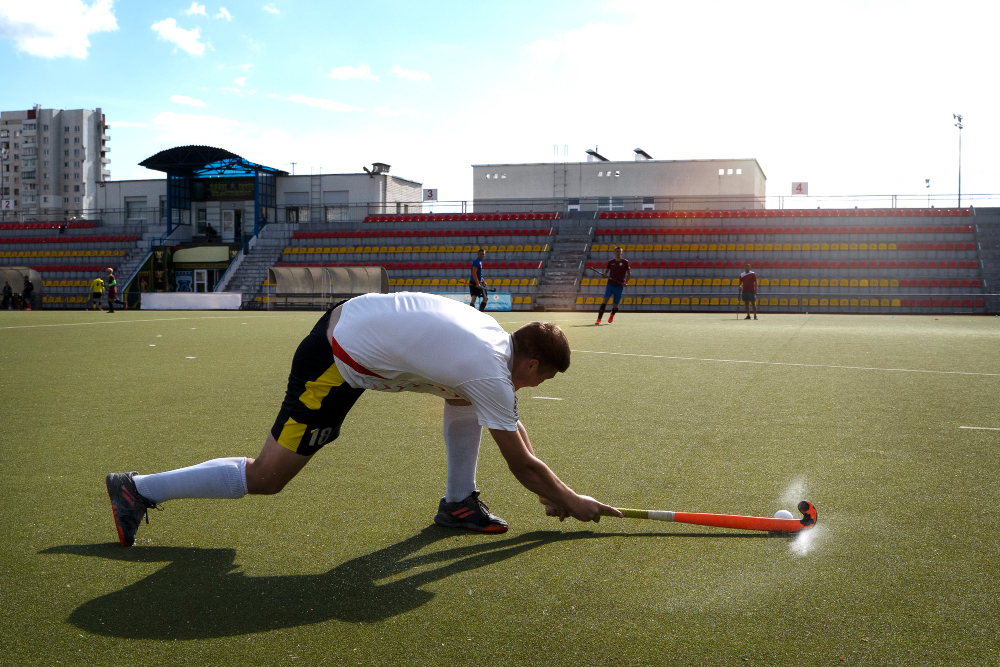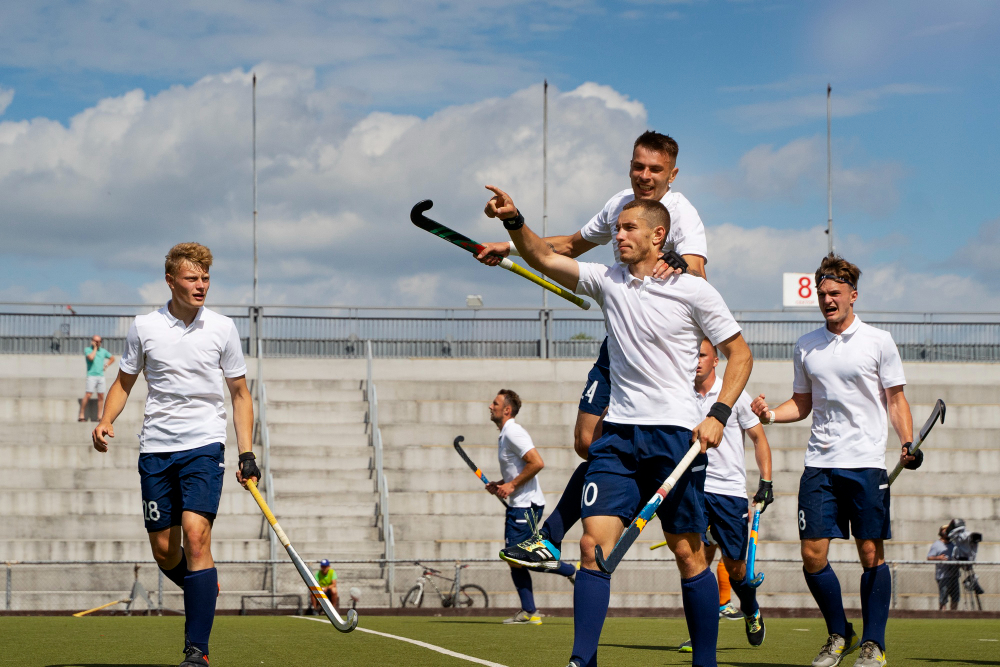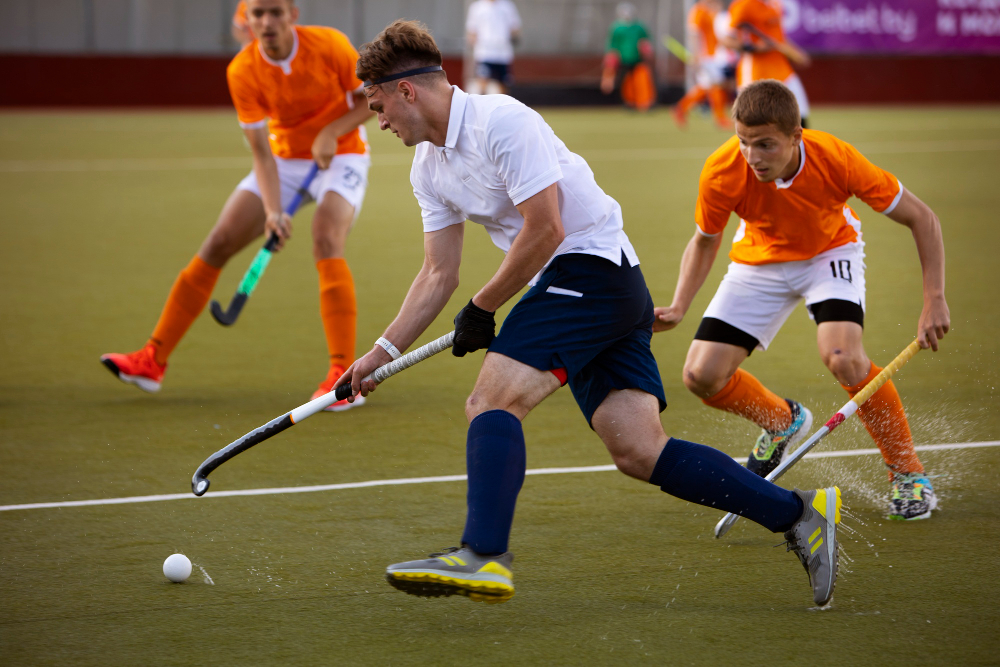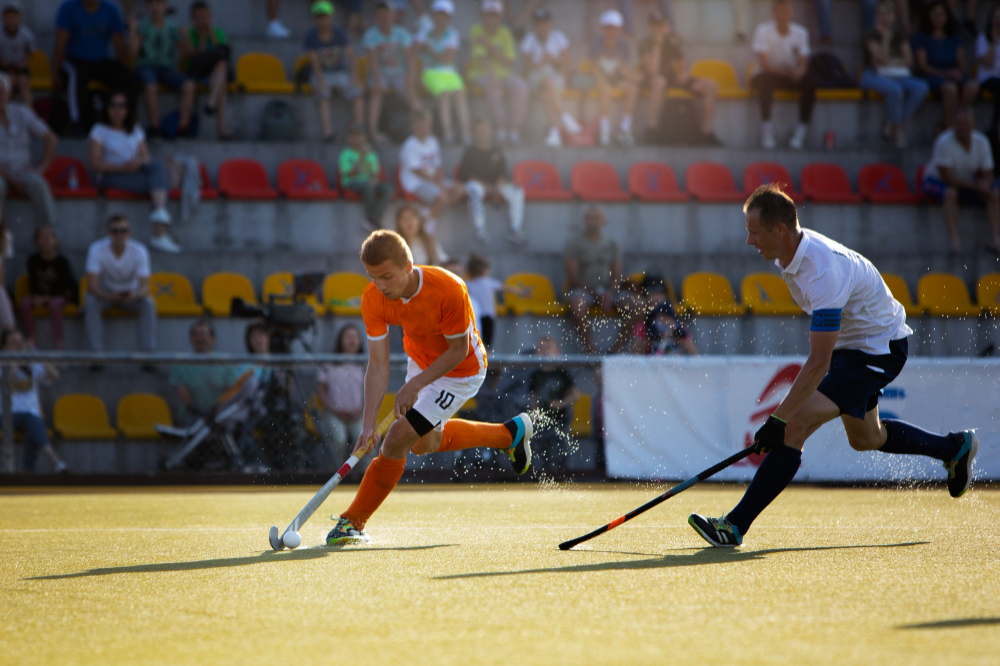A rectangular pitch, usually constructed of artificial turf or grass, is used for field hockey. To score goals, players must use a specialized stick to strike a tiny, hard ball through the opposite team’s goal. There are 11 players on the pitch at once for each side, including a custodian incharge of protecting their team’s goal. At the same time, players must use sticks that feature a flat side for striking the ball.
Besides that, a rounded side can maneuver it and pass the ball to their teammates. The game may start with a pass across the center of the field. However, to intercept throws and defend their goal, players must also utilize their limbs, bodies, and sticks.
What Type of Game is Field Hockey?
Field Hockey is a team sport that includes physical skill, strategic thinking, and teamwork. It’s a dynamic, quick-moving game that calls for extreme fitness, quickness, and agility because it resembles soccer and ice hockey regarding gameplay, positioning, and strategy. However, hockey is sometimes called a cross between the two games. The ball must be passed and received to go up the pitch and score goals in hockey. Furthermore, players control and manage the ball using a specialized stick. Furthermore, unlike football, Hockey players must dodge opponents and defend their goal, much like in ice hockey.
Hockey takes place on a pitch, not on ice, unlike ice hockey. Therefore, players are not permitted direct physical contact with their opponents. Hockey is a distinctive and thrilling sport that calls for a blend of technical ability, physical conditioning, and strategic thought. Throughout all levels of competition, both men and women participate in this well-liked sport.
Why is it Called Field Hockey?
Because it takes place on a field alongside special hockey sticks, the game is known as hockey. The word “field hockey” was developed to distinguish this specific form of the game from other varieties of hockey. Nevertheless, since the expression “hockey” originally applied to a range of stick-and-ball games that were played in various regions of the world,
Field hockey is rooted in multiple stick-and-ball games that originated in Asia, Africa, and Europe several millennia ago. Over time, these contests changed, and by the middle of the 19th century, hockey was a well-liked sport in England.
Therefore, this sport eventually expanded to other regions of the world after the establishment of the first codified regulations in 1875. Furthermore, field hockey is now one of the world’s most well-liked and thrilling collaborative sports, being played by thousands of people in more than 100 nations.
History of Field Hockey
Hockey’s origins may be traced back to the Middle Ages when diverse stick-and-ball sports were played worldwide. Over time, these contests changed, and by the middle of the 19th century, hockey was a well-liked sport in England. Consequently, when the first official regulations of the sport were established in England during the late 1800s, the contemporary version of hockey that we recognize today initially emerged. In 1895, England and Ireland played the first international men’s match, and in 1896, England and Ireland played the first international women’s match, early in the 1900s.
Furthermore, hockey was brought to other regions of Europe, including the United States, before quickly spreading throughout the British Empire. Moreover, hockey was initially incorporated into the Olympic Games in 1908. Perhaps the Worldwide Hockey Federation (FIH) emerged in 1924 to oversee the sport globally.
Hockey equipment and rules have changed to make the game quicker, safer, and more enjoyable. For instance, synthetic grass in the 1970s made play faster and more reliable. However, the use of video-assisted refereeing (VAR) in the past few years has improved refereeing accuracy and minimized mistakes.
Hockey is now one of the world’s most well-liked and thrilling cooperative sports. That is enjoyed by millions of individuals in more than 100 nations. Coordinately, it has a long and varied history that spans centuries and countries. Furthermore, it occurs at all levels, from youth teams to international championships like the Summer Olympics and World Cup.

From Early Greek to the New Version of Field Hockey
Hockey has its roots in several stick-and-ball games that were played around the world. For instance, “keratin,” a game practiced in ancient Greece, required striking a ball with a bent stick. However, a sport titled “shinty” was played in medieval England, and it required hitting a ball with a bar and attempting to score a goal.
When various clubs and schools started to formalize the rules as well as the equipment of the sport. Therefore, in England, within the latter part of the 1800s, the current form of hockey started to take shape.
The first game of contemporary field hockey was played in 1861 in Blackheath, southeast London, and the Blackheath Hockey Club became the first hockey organization. However, field hockey quickly gained worldwide recognition in the following decades, both in England and other countries.
In 1895, England and Ireland competed in the first international game with two national teams, and in 1896, However, England and Ireland squared off in the first international game featuring women.
Hockey had expanded to other regions of Europe, the United States, and Canada by the early 1900s. The first national organizations were established in these nations, and international competition in the sport started.
To oversee the game on a global scale, the World Hockey Association (FIH) was established in 1924. Therefore, FIH now leads the organization of important international tournaments, including the Hockey World Cup. Consequently, it has an Olympic and a Hockey Pro League and more than 130 member associations worldwide.
For instance, the use of visual assist referees (VAR) in the past few years has assisted in reducing errors and enhancing the accuracy of refereeing. Consequently, it is much like how the advent of synthetic grass in the 1970s facilitated faster and more reliable play.
Despite these modifications, hockey has a long and varied history that crosses countries and centuries. Millions of individuals play it worldwide, and its ubiquity and level of competition are rising.
The Game Format of Field Hockey
Hockey is played on a rectangular field by a pair of eleven players, including a goalkeeper, using a ball and special hockey sticks. Therefore, scoring a more significant number of goals than the opposition is the game’s goal.
In most international events, the game is split into two parts, each lasting 35 minutes. However, both periods are fifteen minutes longer in several other tournaments, especially the Olympics and the World Cup. A 10- to 15-minute halftime break is provided.
The ball is placed into play through a “push-back” towards the middle of the field at the beginning of the game and following each goal.
Players may manipulate and control the ball with either side of their sticks, but they are not permitted to use the soles of their feet, hands, or any other body part. Therefore, except the custodian in their assigned area.
The team with the ball is known as the team that attacks, and they are trying to get a goal by kicking the football into the opposition’s net. Therefore, the defensive team works to gain control of the ball and stop the offensive team from scoring.
Two umpires oversee the game and are in charge of enforcing the regulations and guaranteeing fair play. However, video referee assistants (VAR) have recently been used in various events to help eliminate mistakes and increase officiating accuracy.
Hockey is a quick-moving, thrilling sport that calls for talent, strategy, and collaboration. It has a long and varied history that spans centuries and countries. Furthermore, it is played at every level, from juvenile leagues to international contests.
The Rules of Field Hockey
The hockey regulations are set up to promote sportsmanship, fair play, and safety. Therefore, the following constitute a few of the main game rules:
Field Hockey Sticks:
A specialized field hockey stick that complies with the rules set forth by the Worldwide Hockey Federation (FIH) must be used by each player. However, the field hockey stick cannot be broader than 25mm and must be flat on both sides.
Field Hockey Ball:
Composite materials or hard plastic are used to make the field hockey ball. Furthermore, it must be spherical, weigh between 156 and 163g, and have a circumference between 224 and 235mm.
Field Hockey Cleats:
Field hockey cleats are specialized shoes designed for playing field hockey. The cleats help players maintain stability, maneuverability, and control while running, stopping, and changing direction during the game. Field hockey cleats or field hockey turf shoes are designed to offer support, comfort, and durability to withstand the rigors of the sport.
Field Hockey Players Positions:
Eleven players are on the pitch for each team, plus a custodian outfitted in protective gear. Additionally, forwards, midfielders, and defenders make up the remaining players. Defenders operate in the backline, thwarting attacks and initiating offensive plays. Midfielders control the game’s tempo, bridging defense and offense while distributing the ball effectively in the field. In the field hockey positions the goalkeeper guards the goal, preventing opposing goals.
Fouls:
Players are not permitted to control except for the custodian inside their assigned area. Additionally, they should not manipulate the ball with their toes, hands, or any other section of their body. Other frequent offenses include dangerous tackles, blocking, and misusing a stick. Like baseball, field hockey needs the defensive tactics.
Free Hits:
When a foul is committed, the other side is given a free hit they must take from the foul area. However, while a free hit is taken, players on the other side must stay at least 5 meters away from the ball.
Penalty Corners:
A penalty corner is given to the attacking team when a foul is committed inside the penalty-taking circle (the space closest to the goal). Moreover, a player positioned outside the circle receives the ball and pushes it out to them so they can try to score a goal.
Penalty Strokes:
A penalty shot may occasionally be given if someone on defense commits a foul that hinders a clear chance to score. Similarly, only the custodian may defend when a player shoots from the resulting penalty spot toward the goal.
The player takes a shot from the penalty spot, 7 yards (6.4 meters) away from the goal, aiming to score against the goalkeeper.
Offsides:
Hockey does not have an offside rule like other sports. Alternatively, players can go wherever they choose on the pitch if they don’t commit a foul.
Note:
These are only a handful of hockey regulations. Therefore, globally, the World Hockey Federation (FIH) establishes and upholds the game’s rules. Therefore, national as well as regional governing organizations also have their own set of guidelines.
The Pitch Information for Field Hockey
Hockey is played on a rectangular pitch 91.4 meters long and 55 meters wide. The pitch is split into thirds, each 30.5 meters long. The 2.14-meter-high and 3.66-meter-wide goalposts are situated at both ends of the field. Usually, the angle is covered in artificial turf or natural grass. Though the surface has to be level, smooth, and free from any obstacles or dangers that can endanger players,
The many zones and regions of play are denoted on the pitch by several marks. These consist of the following:
- The pitch is divided into two equal components by a line known as the centerline.
- The shooting circle is a semicircle with a radius of 14.63 meters situated in each goal’s direction. During play, the shooting circle may only be entered by members of the assaulting team and the opposing custodian.
- The penalty area is a tiny circle that is situated 6.4 meters from the edge of the goal’s center and where penalties are executed.
- The 23-meter line designates the spot at which free hits granted to the opposing side must be completed, perhaps if the ball crosses the end line out of bounds.
- Despite the sideline where the ball passes out of bounds, play is restarted along these lines that delineate the pitch’s outside limits on each side.
The Benefits of Playing Field Hockey
Playing field hockey has a number of advantages, both psychologically and physically. Here are some of the main benefits:
- This can enhance overall endurance and cardiovascular fitness.
- Hockey is a team-based sport, so playing it effectively calls for effective collaboration, cooperation, and communication.
- Decision-making abilities and mental flexibility may both benefit from this.
- Playing hockey may be a terrific method to reduce stress and enhance general mental health, just like any other type of exercise.
- Overall, hockey can provide players of every age and skill level with a fantastic workout. Furthermore, help them develop their physical and mental capabilities by making it a fun and social activity.
The Future of Field Hockey
With the sport’s global popularity rising, hockey has a promising future. Therefore, the following are some significant trends and advancements to look out for in the upcoming years:
Millions of players:
Hockey now has millions of players worldwide, but there’s still room for development in terms of participation. As a result, many nations are funding grassroots efforts and programs to entice more young adults to pick up the activity.
Technological developments:
Similarly, wearable sensors and video analysis are just a couple of the technological breakthroughs that assist hockey coaches and players.
More variety and inclusion:
Although certain nations and demographics have traditionally dominated hockey, efforts are currently being made to encourage more diversity and participation in the sport. This includes measures that motivate more young females to participate and efforts to advance sports in marginalized communities.
Sustainability:
Like many other sports, hockey is paying more attention to sustainability and environmental responsibility. This includes programs to lower carbon emissions from travel and other happenings. As well as initiatives to encourage environmentally friendly methods of producing and utilizing equipment.
Organized Sports:
Hockey is currently an organized sport in several nations. However, there is still an opportunity for expansion concerning player compensation, sponsorship agreements, and media attention. Professional athletes will have more options to make a living off the sport as it gains popularity.
Hockey has a promising future because it will continue to develop and meet new problems as they arise. There are many exciting changes to watch in the years to come. By contrast, regardless of how much you belong to the player, coach, or fan, you are fascinated with the sport.
Notable Teams in Field Hockey
Both nationally and internationally, there are a lot of notable hockey teams. Here are a few of the most well-known and prosperous groups:

Netherlands:
With multiple Olympic and World Cup victories, the Netherlands is recognized as one of the finest hockey teams in the world.
Australia:
The Australian male and female teams consistently perform well at major competitions, placing them among the greatest in the world.
Germany:
Germany is another hockey powerhouse with a rich history and several major championships.
Argentina:
With a bright and competitive squad that has been progressively increasing in the standings in recent years. Generally speaking, Argentina represents one of the game’s up-and-coming powers.
England:
England is another historically prosperous hockey nation with a long list of major championships to their credit.
Pakistan:
With a long history and several championships, Pakistan is one of Asia’s most successful hockey-playing countries.
New Zealand:
With a bright and competitive squad that has had enormous achievements on the international scene, New Zealand has also recently emerged as a serious competitor.
Note:
These are only a handful of the illustrious teams on the hockey globe; several nations and domestic teams have excelled and made significant contributions to the sport’s lengthy history.
The Most Popular Players in Field Hockey
Field hockey has produced numerous outstanding players throughout the years. Although all of them have their unique abilities and playing styles, Therefore, arguably the most well-known and well-liked players are listed below:
Dhyan Chand:
Dhyan Chand is one of the finest athletes in field hockey of all time. He has won three gold medals at the Olympics. As a result, he is renowned for his prodigious talent, quickness, and accuracy.
Jamie Dwyer:
Former Australian footballer Jamie Dwyer is recognized as one of the top athletes of his time. He received numerous medals and honors throughout his career and is renowned for his exceptional stickwork and attacking skills.
Luciana Aymar:
Luciana Aymar, one of the greatest female athletes in field hockey history, has won several prestigious awards and championships. She is renowned for her on-field agility, quickness, and tactical understanding.
Teun de Nooijer:
Teun de Nooijer, a retired Dutch footballer, is hailed as one of his generation’s top players. He received many medals and honors throughout his career and is renowned for his exceptional stickwork and originality on the field.
Sohail Abbas:
Former Pakistani footballer Sohail Abbas is regarded as one of the greatest drag flickers in history. He is renowned for his strong and precise drag flicks; however, he owns the world record for the most significant number of goals scored in field hockey history.
Ellen Hoog:
Former Dutch player Ellen Hoog is renowned for her talent, quickness, and attacking power. Therefore, throughout her career, she received numerous medals and honors. Although she is regarded as being one of the most outstanding female athletes in field hockey from her generation,
Inscription
These individuals are just a handful of the many well-known and well-liked field hockey players; many more have excelled in the sport and made essential contributions to its illustrious past.
FAQs
How many players are in field hockey?
Two teams consisting of eleven (11) players, including a goalie, normally play field hockey. Yet there are variants of the game involving fewer teams of between five and six players, like indoor hockey.
What is it called hockey?
The reason the game is now known as “hockey” is because it initially consisted of playing with a stick that was curved and known as a “hock” or “hook.”
What are the main points of hockey?
The fundamentals of hockey involve employing a stick to propel a ball called a puck into the other team’s goal while adhering to the regulations and working as a team.
Where is hockey popular?
Many nations enjoy hockey, but it is especially popular across Canada, the United States of America, Russia, Sweden, Finland, and a number of other European nations.
Who is known as the “father of hockey”?
James Creighton is regarded as “the patriarch of hockey” because of his contribution to the early organization and growth of the game.

Conclusion
Field hockey remains a well-liked sport with a long history practiced by thousands worldwide. The game is appreciated by enthusiasts and professional players and is known for its fast-paced action. Although deft stick handling and strategic play, field hockey has continued to grow and develop despite some difficulties in recent years. New regulations, technologies, and training techniques are making the sport safer, more thrilling, and more widely available than ever.
Field hockey offers a distinctive and fulfilling experience that has captivated the hearts and minds of spectators. As a result, players worldwide play, whether for recreation, fitness, or competition. Therefore, the potential of field hockey to unite individuals from many backgrounds and cultures is one of its most exciting features. The activity is famous worldwide and has emerged as a unifying factor that cuts through national boundaries and linguistic difficulties.
Players and supporters of the sport are able to bond over their shared passion for field hockey by exchanging stories and celebrating victories. One of the primary reasons field hockey has been a well-liked sport for decades. However, it will likely continue to expand and adapt in future generations because of this sense of brotherhood and camaraderie. Field hockey presents a distinctive and fulfilling experience, whether taking the game from the stands or participating on the field.

